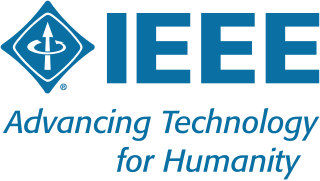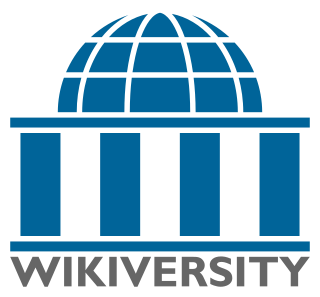
The Institute of Electrical and Electronics Engineers (IEEE) is a 501(c)(3) professional association for electronics engineering, electrical engineering, and other related disciplines with its corporate office in New York City and its operations center in Piscataway, New Jersey. The mission of the IEEE is advancing technology for the benefit of humanity. The IEEE was formed from the amalgamation of the American Institute of Electrical Engineers and the Institute of Radio Engineers in 1963.
A pedagogical pattern is the re-usable form of a solution to a problem or task in pedagogy, analogous to how a design pattern is the re-usable form of a solution to a design problem. Pedagogical patterns are used to document and share best practices of teaching. A network of interrelated pedagogical patterns is an example of a pattern language.

Constructivism is a theory in education which posits that individuals or learners do not acquire knowledge and understanding by passively perceiving it within a direct process of knowledge transmission, rather they construct new understandings and knowledge through experience and social discourse, integrating new information with what they already know. For children, this includes knowledge gained prior to entering school. It is associated with various philosophical positions, particularly in epistemology as well as ontology, politics, and ethics. The origin of the theory is also linked to Swiss developmental psychologist Jean Piaget's theory of cognitive development.
Educational technology is the combined use of computer hardware, software, and educational theory and practice to facilitate learning. When referred to with its abbreviation, edtech, it often refers to the industry of companies that create educational technology.
Computer-supported collaborative learning (CSCL) is a pedagogical approach wherein learning takes place via social interaction using a computer or through the Internet. This kind of learning is characterized by the sharing and construction of knowledge among participants using technology as their primary means of communication or as a common resource. CSCL can be implemented in online and classroom learning environments and can take place synchronously or asynchronously.

Gráinne Conole is an Irish-born professor and educational researcher, based in England. She was Professor of Learning Innovation and Director of the Institute of Learning Innovation, University of Leicester. Prior to this, she was Professor of eLearning at the Institute of Educational Technology in the UK's Open University. Previously she had a chair in education at the University of Southampton and was also previously director of the Institute for Learning and Research Technology at the University of Bristol. Professor Conole was named an EDEN Fellow in 2013 and was awarded a National Teaching Fellowship from the Higher Education Academy and ASCILITE Fellow Award in 2012.
An Internet scavenger hunt or CyberHunt is an educational lesson which introduces the Internet to students. It is often used as tool for teaching students how to search the Internet and how to use the resources and information available on the Internet. It is an online activity in the form of a scavenger hunt that focuses on gathering information from web sites to answer questions or to support a concept on a particular theme or content area. The intent is to hunt for facts or information to add details for the answer to the question. The questions themselves may vary from the simple fact or statement to the more complex, depending upon the age and skill level of the student. By completing CyberHunts, students learn how to navigate a web site, scan a page for detailed information, and then apply the facts or ideas to the question. A CyberHunt is an excellent way to teach beginning internet researching skills.
An edublog is a blog created for educational purposes. Edublogs archive and support student and teacher learning by facilitating reflection, questioning by self and others, collaboration and by providing contexts for engaging in higher-order thinking. Edublogs proliferated when blogging architecture became more simplified and teachers perceived the instructional potential of blogs as an online resource. The use of blogs has become popular in education institutions including public schools and colleges. Blogs can be useful tools for sharing information and tips among co-workers, providing information for students, or keeping in contact with parents. Common examples include blogs written by or for teachers, blogs maintained for the purpose of classroom instruction, or blogs written about educational policy. Educators who blog are sometimes called edubloggers.
The Australasian Society for Computers in Learning in Tertiary Education, also known as ASCILITE is an incorporated not-for-profit professional association for those engaged in the educational use of technologies in tertiary education. The association, which was incorporated in the state of South Australia in 1987 is governed by the ASCILITE constitution and by-laws in accordance with the Associations Incorporations Act 1985.
E-learning theory describes the cognitive science principles of effective multimedia learning using electronic educational technology.

The Medical Journal of Australia is a peer-reviewed medical journal published 22 times a year. It is the official journal of the Australian Medical Association, published by Wiley on behalf of the Australasian Medical Publishing Company.

This National Conference is the biennial conference of the Australian Council for Computers in Education (ACCE). The conference opens to anyone who in interested in sharing their digital teaching experiences. The first conference took place in Melbourne, 1983. Between 1983-1996, the conference was held annually across Australia. After 1996, the conference became biennial. From 1994, a series of frameworks were launched in Australia to integrate Information and Communication Technology(ICT) into education. Western Australia's 2001 Competency framework for Teachers identified teachers as an important component in developing computer education. In 2010, Education Minister Julia Gillard, proposed an education agenda to provide Australia a better education system. Besides ACCE, there are many organizations and conferences supporting the development of computer education in Australia. Technology in education consists of two major approaches: Learning with technology and learning from technology. Technology in education learning and traditional classroom learning have different focuses and defining features. There are also four types of computer education:Bring your own device(BYOD), blended learning, online learning, and flipped learning.

Wikiversity is a Wikimedia Foundation project that supports learning communities, their learning materials, and resulting activities. It differs from Wikipedia in that it offers tutorials and other materials for the fostering of learning, rather than an encyclopedia. It is available in many languages.

A virtual learning environment (VLE) is a system that creates an environment designed to facilitate teachers' management of educational courses for their students, especially a system using computer hardware and software, which involves distance learning. In North America, a virtual learning environment is often referred to as a "learning management system" (LMS).
Communication Education is a peer-reviewed publication of the National Communication Association published by Taylor & Francis. Communication Education publishes original scholarships that advance understanding of the role of communication in the teaching and learning process in diverse spaces, structures, and interactions, within and outside of academia. Communication Education welcomes scholarships from diverse perspectives and methodologies, including quantitative, qualitative, and critical/textual approaches. All submissions must be methodologically rigorous and theoretically grounded and geared toward advancing knowledge production in communication, teaching, and learning.
One of the most visible approaches to peer learning comes out of cognitive psychology, and is applied within a "mainstream" educational framework: "Peer learning is an educational practice in which students interact with other students to attain educational goals." Other authors including David Boud describe peer learning as a way of moving beyond independent to interdependent or mutual learning among peers. In this context, it can be compared to the practices that go by the name cooperative learning. However, other contemporary views on peer learning relax the constraints, and position "peer-to-peer learning" as a mode of "learning for everyone, by everyone, about almost anything." Whether it takes place in a formal or informal learning context, in small groups or online, peer learning manifests aspects of self-organization that are mostly absent from pedagogical models of teaching and learning.
Open Educational Resource (OER) Universitas is a collaboration of post-secondary educational institutions and other organisations with the aim of providing opportunities to learn from open educational resources and gain credit at costs lower than traditional degrees. The conceptual framework underpinning ENGAGEDe in free learning, and receive formal accreditation from participating universities. It is possible to use OER Universitas partners as an alternative paths to earning a degree
Alastair Gibson Smith was a New Zealand academic in the field of library and information science. He retired in 2014 after spending most of his career at Victoria University of Wellington.
Alan Amory is a professor of educational technologies at the University of Johannesburg, where he promotes and drives the use of educational technologies. He has contributed to numerous fields of research, including information and communication technologies in education, video games and learning, tool-mediated knowledge construction, authentic learning, and Cultural Historical Activity Theory (CHAT).
Electronic exams offer benefits such as ease of marking, reduced need to read illegible handwriting, saving of time






